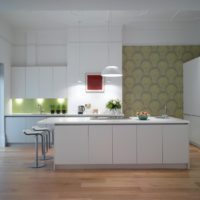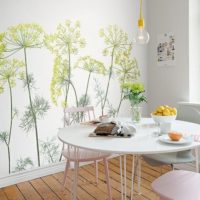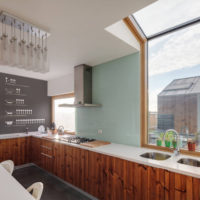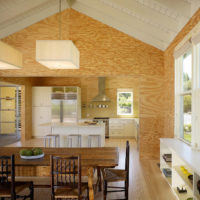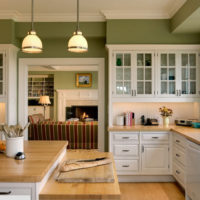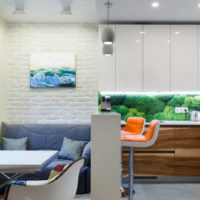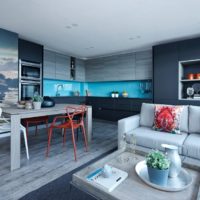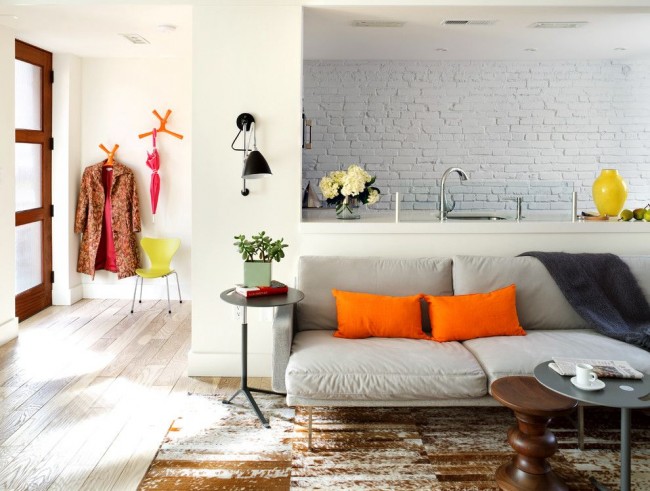Wall design in the kitchen. What should I look for when planning walls in the kitchen?
One of the rooms in the apartment where quite a lot of time is spent is the kitchen. Due to the specificity and functionality, the design and filling of the kitchen must take into account many important aspects: convenience, beauty, ergonomics. It is important to rationally plan, consider materials for wall decoration. All this will help save time on cleaning, increase wear resistance.

The walls in the kitchen should remain attractive for a long time, despite the impact of negative factors
Paying attention to the separate material for the walls, it is important to consider the following:
- In the kitchen, there are often temperature differences, the choice must comply with the requirements for ensuring moisture resistance. Moreover, the surface should not change the structure and appearance of frequent washing.
- The material from which the wall decor is made should not be toxic.
- Aesthetic appearance.
- High resistance to mechanical damage.
The design of the walls in the kitchen is a matter that requires a serious and thoughtful approach.

In the kitchen, it is appropriate to combine finishing materials based on the functionality of a wall segment
Content
What decor options are popular, the main characteristics
Having considered the popular finishing materials, it is worth noting one of the types - this is wallpaper for the walls. Marking will help to determine and select the desired for the purpose, according to all operating conditions type. Moisture-resistant are suitable for the kitchen area. According to the marking, the “wave” icon will indicate moisture resistance, and the “wave with a brush” will also indicate mechanical stress.

When choosing a wallpaper, the placement of windows is taken into account - the direction of light is very significant in interior design
To choose a wallpaper, you should pay attention to some more options.
- This is the density on which "porosity" depends. In other words, the denser it is, the less likely it is that pests and bacteria will settle in the pores, which will ensure hygiene during harvesting and resistance to impact.
- The next parameter is light fastness. The kitchen does not hang thick and excessively dark colored curtains that can absorb all the smells and interfere with the penetration of light from the windows. The kitchen is a bright space and with low light fastness the wallpaper will quickly fade. The view will be unattractive, spoiling the entire interior of the kitchen.
- Depending on the design, you can choose the color and pattern for the appropriate size of the kitchen, using wallpaper for painting with the possibility of multiple staining. And the kitchen will always look bright, and each time refreshing idea after idea.

Light wallpapers will make the kitchen more spacious and make up the perfect backdrop for any decoration
To properly plan the design of the walls in the kitchen, you must take into account some rules.
- For a small-sized kitchen - the walls should be as lighter as possible, and the color scheme should be combined with furniture. And the picture on the wallpaper - match the picture in the interior of the kitchen. The chosen design according to the country style presupposes the presence of a small pattern, the image of flowers, vegetables, fruits in combination with classic furniture and decor.
- Sometimes, to revitalize the interior, use, as an option, plain wallpaper or stripes. At the same time, you can dream up with the decor on the wall.Bright, colorful stripes will enliven and add festivity.

Dark wallpaper in the kitchen is an eccentric and bold solution, but if you combine them correctly with a white set, a very interesting interior will come out
Varieties of wallpaper
- Paper. Not the best choice for the kitchen, as they quickly fade, are torn. Cheap and fast wearing, impractical. Very whimsical finishing material and is not recommended for wall decoration in the kitchen.
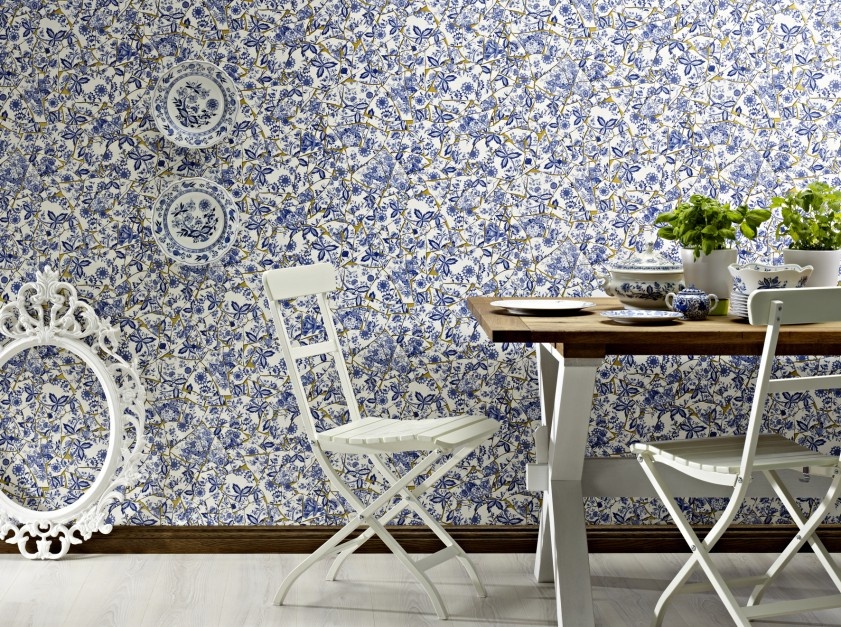
Sticking paper wallpapers in the kitchen is not recommended
- Washable. Given the resistance to detergents, this option is more practical than paper wallpaper.

Washable paper-based wallpapers are pasted away from the work area
- Duplex. Wallpaper with latex coating, but on a paper basis. They behave remarkably in the kitchen, since, although pressed paper, it is precisely due to the coating that they are moisture resistant, do not fade, do not wear out. As an alternative, it can replace, as a finishing material, ceramic tiles, which makes it possible to reduce the price of a choice without losing practicality in the interior of the kitchen.

Duplex - the best option among paper-based wallpapers
- Liquid. They are applied to the walls like ordinary plaster, which is very convenient and practical. There is no need to specially and thoroughly prepare the surface. When applied to the walls, all cracks are filled, hiding flaws, defects, protrusions, corners. There are many advantages in operation. Since cellulose, cotton and silk are included, non-toxicity is ensured. Resistant to moisture, have sound insulation properties, do not fade. But the color palette can be chosen diverse.

Liquid wallpaper can deteriorate from water, therefore it is better not to use them in the working area
- Vinyl. Many advantages: moisture and wear resistance, can be washed, do not fade. The only ones that are not an economical option because of their price.

Foamed vinyl has a particularly dense structure and perfectly hides small small irregularities in the walls
- Fiberglass. Looks perfect in the interior of the kitchen. They are moisture resistant, practical, durable. But, if the choice fell on such wallpaper, then it will be almost impossible to replace them, since after attaching to the wall - this is forever. Changing the design and interior with replacing the texture of the walls is impossible.

A flexible glass fiber web is ideal for those who appreciate simplicity and reliability.
- Photowall-paper. Due to the concentrated ornament, drawing, you can focus on a separate part of the kitchen, on a free wall.

Photowall-paper can become bright addition if they organically fit into the general atmosphere of the room
Other materials
To change the color scheme of the interior, design, you can apply the painting of the walls, after preliminary preparation of the surfaces. This can happen brightly and festively, especially for those who have neither the desire nor the ability to mess around with wallpaper and ceramic tiles. The paint is used on a water-based basis with the addition of polymers and pigments.

Moisture-resistant washing paint is suitable for kitchen walls
Polymers deserve special attention. Acrylic based paints are better than those based on PVA, which is unstable to moisture. With acrylic, the walls look velvety. The best component among polymers is latex or silicone. According to the known properties, it is logical to assume that a film is formed on the walls that protects against all external influences. It is also a very practical and wear-resistant finishing material.

Glossy surfaces look great and visually increase the space, but on such walls even small errors of decoration are striking
To simulate any decor material: paper, wood, leather, stone, metal, decorative plaster is used. The interior in this case looks luxurious, which is more advantageous as an option for decorating the walls of the kitchen. A variety of color palettes will allow you to create any picturesque masterpiece. The many benefits of this type of finish.
Decorative plaster is easy to use, following the instructions, you can decorate almost any surface from concrete to brick, metal, plastic, glass. This material, in addition to everything, is also an excellent insulating material, both for suppressing noise and maintaining heat. It is very practical, rational. The advantages can also include moisture resistance, non-toxicity, durability. But it should be noted uneconomical, as it has a high price and high consumption. If the choice of a high-class interior is not materially limited, then you can safely recommend decorative plaster. Decorative plaster will look very beautiful, and for a long time will be pleasing to the eye.

Decorative plaster provides an opportunity to implement a unique and inimitable design that takes into account the wishes of the owners
It is customary to decorate the working wall in the kitchen with ceramic tiles. This is practical, since the working part is more prone to contamination, and, therefore, often needs cleaning and tidying. The ceramic wall is very resistant, even to strong aggressive detergents. To highlight the functional areas, you can use a combination of different types of wall decoration in the kitchen. Ceramic tiles can be combined from tiles of different sizes and colors. Grout is also necessary to use the standard. It can be decorated at your discretion by adding pigments.

Ceramic tile is durable, resistant to temperature and moisture, easy to clean and goes well with other finishing materials
The design of the walls of the kitchen should correspond to the chosen style and color. The wall of decorative brick looks stylish. This will bring comfort on the one hand and an element of rustic or urban style on the other. Decorating with decorative bricks can be combined with other types of finishes - such as plastering or painting. And it’s beautiful to distinguish by turning interspersed with wood, wood products that functionally fit into the design of the kitchen. It can be shelves with flowers or dishes, with decorative crafts made of various materials. They will look cute and create a cozy atmosphere and plants hanging from the walls, both from artificial and from living leaves and flowers. Brick finish is quite practical, moisture resistant, meets many requirements of the operation of the kitchen area.
Final recommendations
To create coziness, the area at the dining table can be decorated with paintings, shelves with various figures made of wood or ceramics. In the interior of the kitchen, this will add personality and originality. Some images can be selected so that they cause appetite. This can be handmade applications and the like unique things made by yourself or handmade by order.

Plates on the kitchen wall are almost a tradition

Kitchen utensils themselves are good decorative elents
And you can hang an image of a spreading family tree, candelabra, all kinds of candlesticks, chandeliers, family services, following the old noble traditions. If the dining table is near the wall, then it’s not bad to highlight this wall. You can use a different ornament, color, type of decoration, and if you are an artist - take a brush, paints and create in your hand. To decorate the dining table, you can put a vase of fruit on it.

Cork wood is one of the most unusual materials used to decorate walls. Recently it has been replacing ceramics, glass and wood, which are familiar to us. Environmentally friendly, resistant to moisture and high temperature
Work areas can be distinguished by adding additional lighting or lighting panels, which will be a good helper for cooking culinary dishes.

Artificial stone is another great option for decorating walls in the kitchen.It looks more effective than decorative plaster, it can be replaced with tiles and washable wallpaper.
The area near the plate and the working surface of the walls is made of glass. It is easy to clean and photos can be placed behind it.
An interesting design option can be decorative painted ceramic plates. This will emphasize the homely atmosphere. Add coziness using solid wood furniture, linen napkins, burlap, knitted onions, garlic, pepper. Set up a flower pot and plant beautiful flowers. Or create a whole floral panel.

Open shelves look good, are used to store utensils, and you can make them yourself
The kitchen looks very original with the use of PVC and MDF wall panels in decoration. Gives individuality to the wall panel, which distinguishes a large-scale section of the wall or the entire wall, depending on the theme and materials for the panel (shells, fabric, wood, etc.). Very successfully, the interior uses modular paintings that combine a common design style. It looks very stylish and modern.

A significant advantage of the panels is that they will hide any errors in the decoration of the walls, and at the same time you can hide the wiring under them
The cork panels look original and warm. Post hostess notes or recipes on the walls. Leave some cookbooks and books recommending healthy eating in the buffet. Make a series of hidden secret niches with all kinds of spices, pots and pans so that they do not occupy a significant place in sight. This will save free space in the kitchen and give more functionality when cooking culinary masterpieces.
If you follow the urban style, then you need to use glass, plastic, metal parts. Furniture, respectively, should be non-solid, as an option - folding. Use vinyl stickers. They are easy to change and adjust to any style and theme.

Brick walls give a special charm to the kitchen.
If the kitchen is small - you need to try to place the utensils and all the necessary kitchen utensils compactly, add more light. As lighting, you can use LEDs. For the effect of increased space, it’s nice to use glossy or mirror surfaces such as tiles.
As curtains on the windows, you can use tulle, silk, nylon, linen, blinds, depending on the chosen style and design. Everything should correspond and not create a visual sense of disharmony. The color scheme can contrast or harmoniously combine with the rest of the interior and decor.

If the curtains will play a purely decorative role in the kitchen, the visual characteristics will be enough to choose

Curtains can visually adjust the kitchen and hide its imperfections
Everything that is used as a decor for walls, furniture, lighting, textiles should create a common image and concept in perception, while not contradicting convenience and functionality. But one must also work with imagination carefully - do not oversaturate the kitchen and litter the space. Follow the principle of ergonomics. You should not put the stove in the corner. This will cause a lot of inconvenience. The kitchen should be easily ventilated, have excellent ventilation and exhaust. It is necessary to exclude areas of accumulation of smell, soot, dampness. Be sure to treat the walls from insects and other pests to the final decoration and furnishings with furniture and appliances.
Video: review of popular wall coverings





